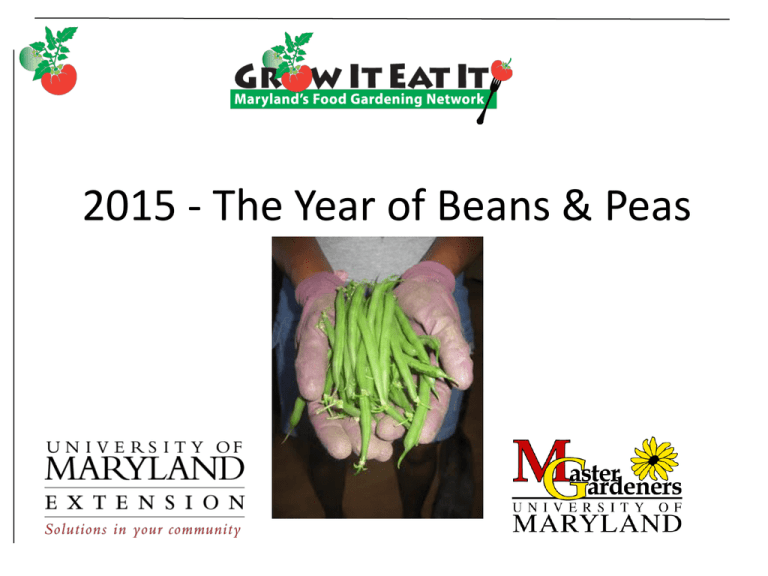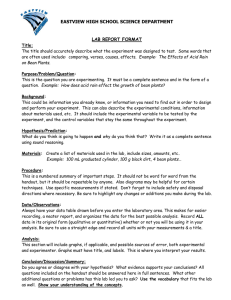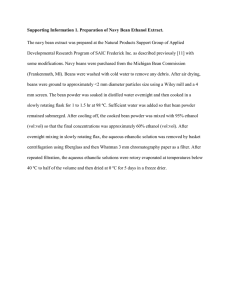MG25 Beans and Peas
advertisement

2015 - The Year of Beans & Peas College of Agriculture and Natural Resources Garden to table! All in the family… • • • • • • • Green bean (bush and pole) Lima bean (bush and pole) Shell beans Garden pea/edible pod pea Cowpea Soybean Scarlet runner bean • Peanut ‘Borlotto’, an heirloom shell bean These are all members of the Leguminosae (a.k.a Fabaceae) plant family and are referred to as legumes Other edible legumes • • • • • • Garbanzo bean (chickpea) Lablab (hyacinth) bean Tepary bean Pigeonpea Lentil Fava bean Fava bean flowers Photo: Luke Gustafson Beans popular in Asian cuisine • Soybean • Yard-long bean • Sword bean • Winged bean Two snow pea varieties Photo: Erica Smith Add pea flowers and shoots to salads ‘Sugar Snap’ peas Photo: Kent Phillips Reasons to grow legumes • • • • • • • Most grow well in MD; good beginner crop Lots of different types You get a lot from a small space Multiple crops each season Easy to save seed Can be frozen, canned, pickled, and dried “Fix” nitrogen from the air N-fixation Rhizobia nodules • Rhizobia (bacteria) occur naturally in soil. They infect legume roots and form a symbiotic relationship • Plant forms protective nodules around multiplying bacteria • N2 gas is transformed by rhizobia into ammonia (NH3) that plant cells use to make plant compounds (especially proteins) • Red or pink color in nodule cross-section indicates that rhizobia are active Inoculation can increase yield And they are pretty! Planting basics • Full sun location: 6-8 hours of direct sunlight • 6-8 inches of loose, fertile soil • Start planting beans in late April/early May; bush beans can be planted up to early July • Plant peas (cool-season crop) in March/April for June harvest. Difficult to grow a fall crop • Note: seeds may rot if planted in cold, wet soil Planting tips • Drag a stick or tool through the soil to make a shallow furrow • Drop seeds every 1-4 inches (follow packet instructions) • Cover with soil (½-inch in spring and 1-inch in summer). Press down to make good seed-soil contact • To save space, plant bush beans and snap peas in short rows 1-2 feet apart Get a head start… • Soak seeds in water overnight prior to planting • Pre-germinate seeds indoors on moist paper towels • Start seeds indoors and set out transplants Growing tips • Apply nutrients according to soil test results. Nitrogen is nutrient most often in short supply • Water your planted seeds and young plants if needed. Don’t let them get water-stressed! • Remove weeds by hand or with a hoe or weeder. A layer of organic mulch will prevent weeds and keep the soil moist and cool in summer • Pick pods as soon as they are ready. This stimulates new flower and pod growth If possible, install drip irrigation: it saves time and water Tatsoi plants in a bed with a drip line for each row Photo: Kent Phillips If possible, use vertical space • Increase yields per sq. ft. • Easier to water, fertilize and harvest. • Adds complex texture to garden; use shaded side for lettuce and spinach Integrated Pest Management (IPM) • Organic pesticides are a last resort • Plant flowering plants in and around the garden that provide nectar and pollen for beneficial insects that eat pest insects. Examples: mountain mint, anise hyssop (left), thyme, oregano, basil, dill, yarrow, aster, marigold, zinnia, alyssum, phlox, bee balm, milkweeds, butterfly weed, borage, salvias, lamb’s ear Biological control • Give mother nature a chance! – Predators eat pests – Parasitoids lay their eggs on or in pests; larvae consume the host Some natural predators (good guys) Orb-weaver spider Lady beetle larva Assasin bug Mantid eating a stink bug Some bean plant enemies (bad guys) #1: Mexican bean beetle- “skeletonizer” Adult, larva, and egg mass Who has been eating my leaves at night? #2: Night-feeding beetles! Oriental beetle Bean leaf beetle #3: Japanese beetle populations were high in 2014 and could be a problem in 2015. #4: Brown marmorated stink bug (BMSB) Eggs and young nymphs Adults feeding on bean pods Photo: Entomolgy Dept., UFL Injury image from plantManagementnetwork.org 2nd to 5th instar BMSB USDA ARS “Stippling” symptom during hot, dry weather? Look at leaf undersides for spider mites. #5: Spider mites European red mites on leaf underside #6: The kudzu bug, an exotic invasive pest, has arrived- late season feeding possible on all garden beans. http://mdkudzubug.org/ Top photos (eggs and nymphs): Joe Eger, Dow Agrociences, Bugwood.org Right photo (adult): Alan Leslie, UM Organic management • Grow healthy plants with the right amounts of sun, space, water, nutrients • Improve soil quality with organic matter • Remove weeds; clean up and compost garden residues • Handpick insect pests and remove damaged and diseased leaves • Only use organic pesticides as a last resort. Don’t spray when flowers are open • Try using floating row covers Floating row covers • • • • First line of defense against spring frost Hastens germination and promotes early growth Excludes pests- rabbits, birds, deer, beetles, etc. Can be left on for entire lifecycle of early bean or pea plants • Note: can trap excessive heat and damage plants after July Floating row cover supported by #9 wire above; bird netting supported by pvc pipe below Enviromesh protects crops from insects and wildlife Resources • Grow It! Eat It! http://www.extension.umd.edu/growit – We have all types of practical food gardening tips and information. Check out our popular blog! • Home and Garden Information Center http://www.extension.umd.edu/hgic – Here you will find factsheets, photos, and videos. You can also subscribe to the free monthly e-newsletter. – We answer gardening questions 24/7…just click “Ask Maryland’s Garden Experts” • Maryland Master Gardener Program http://www.extension.umd.edu/mg – Consider becoming a trained MG volunteer! This program was brought to you by the Maryland Master Gardener Program ______ County University of Maryland Extension




